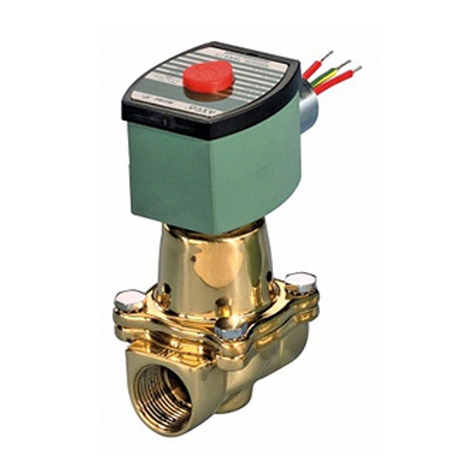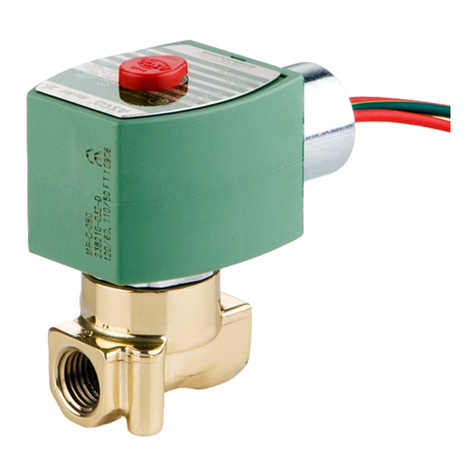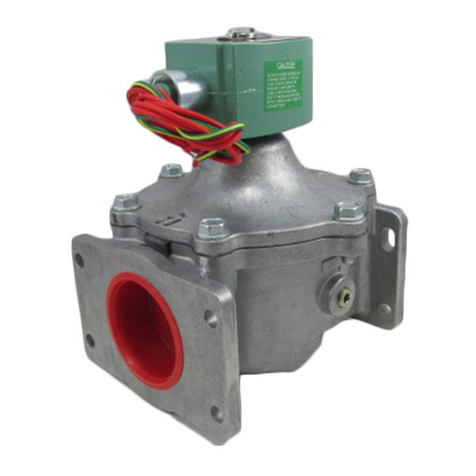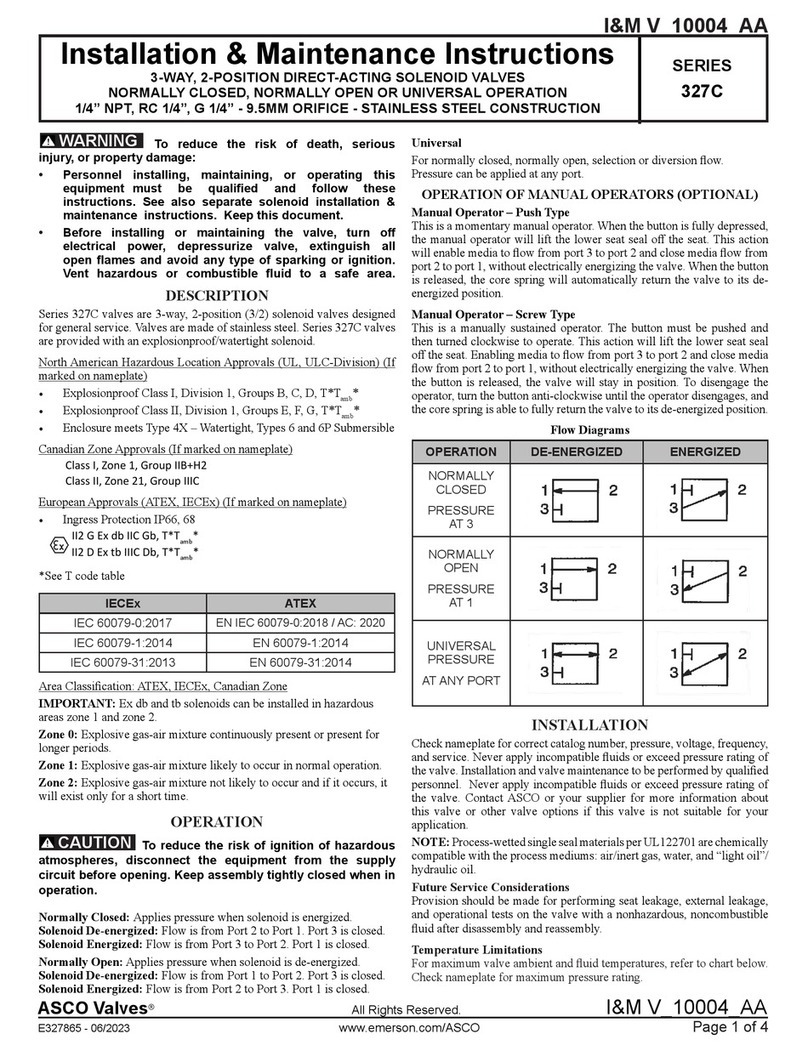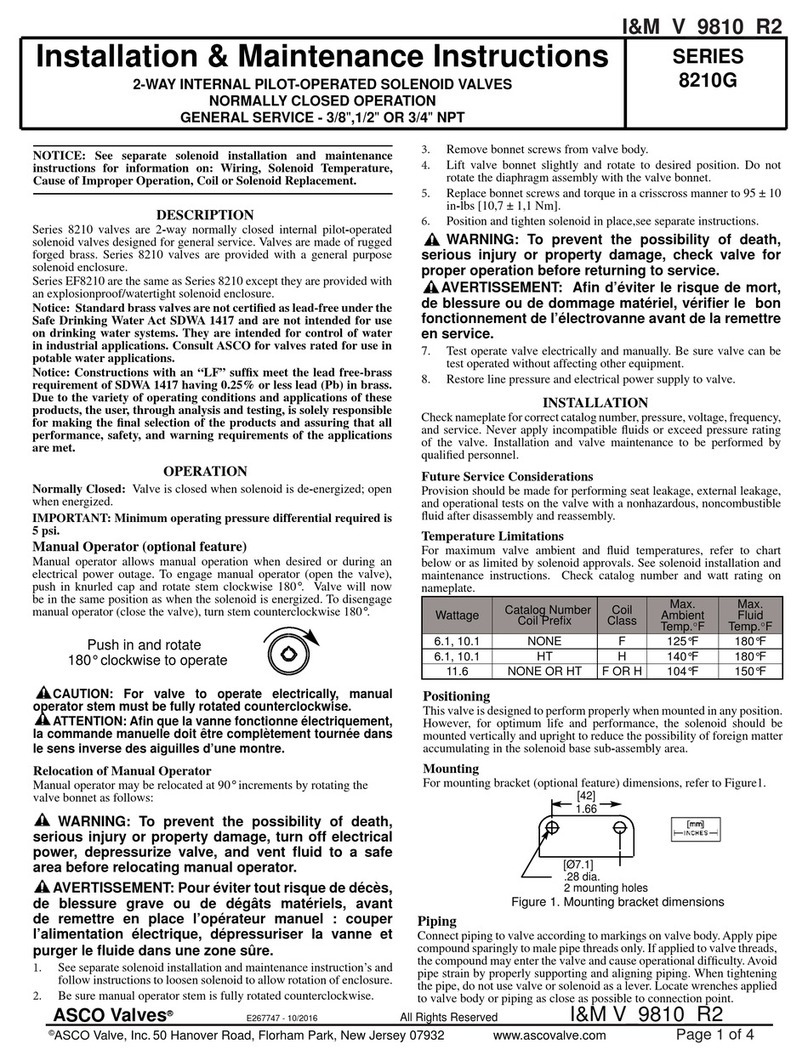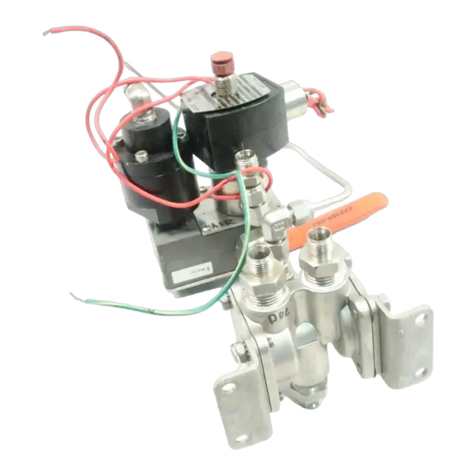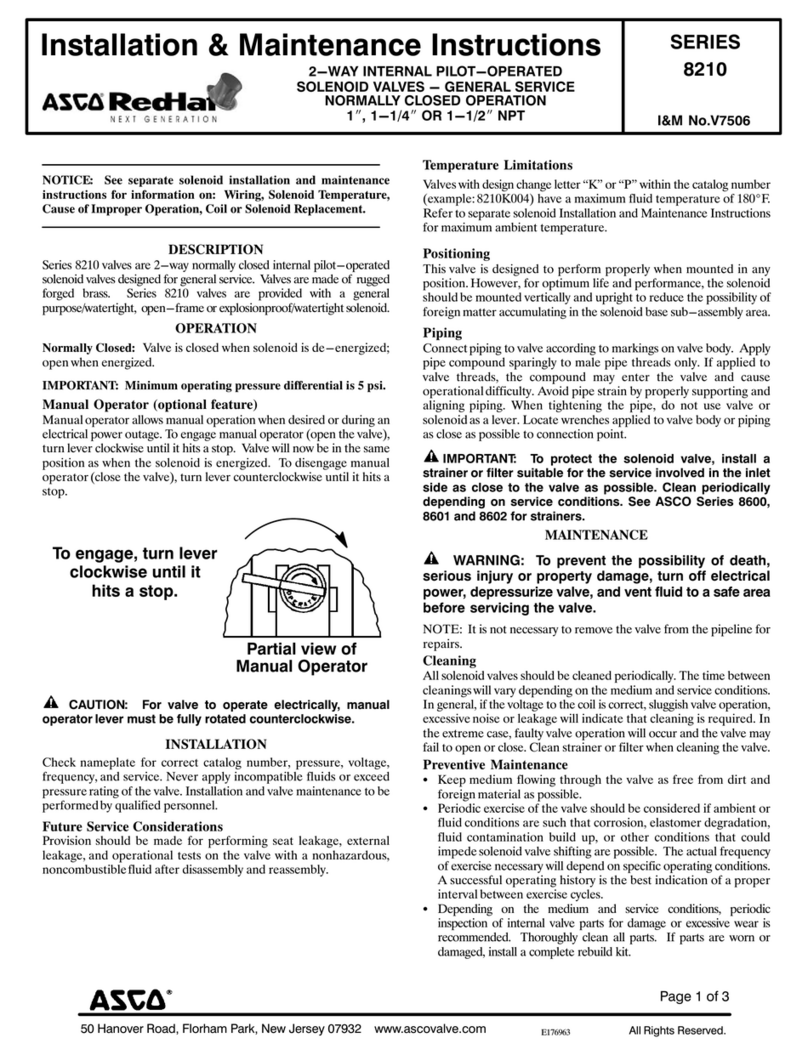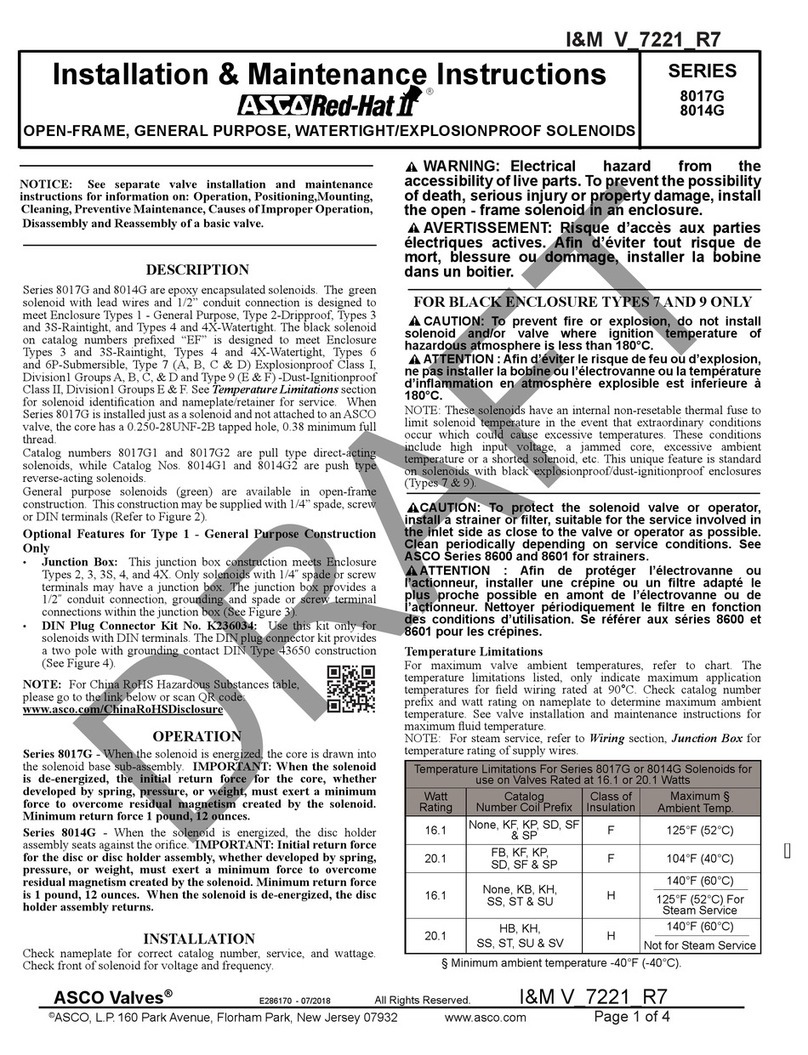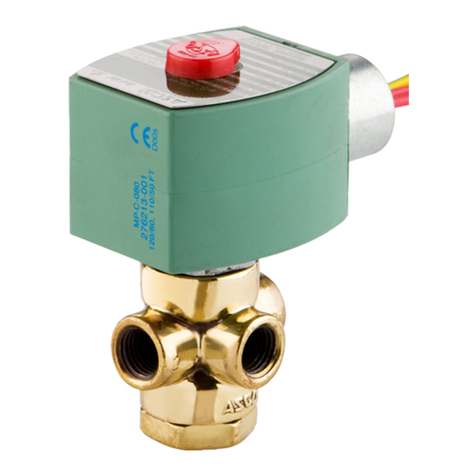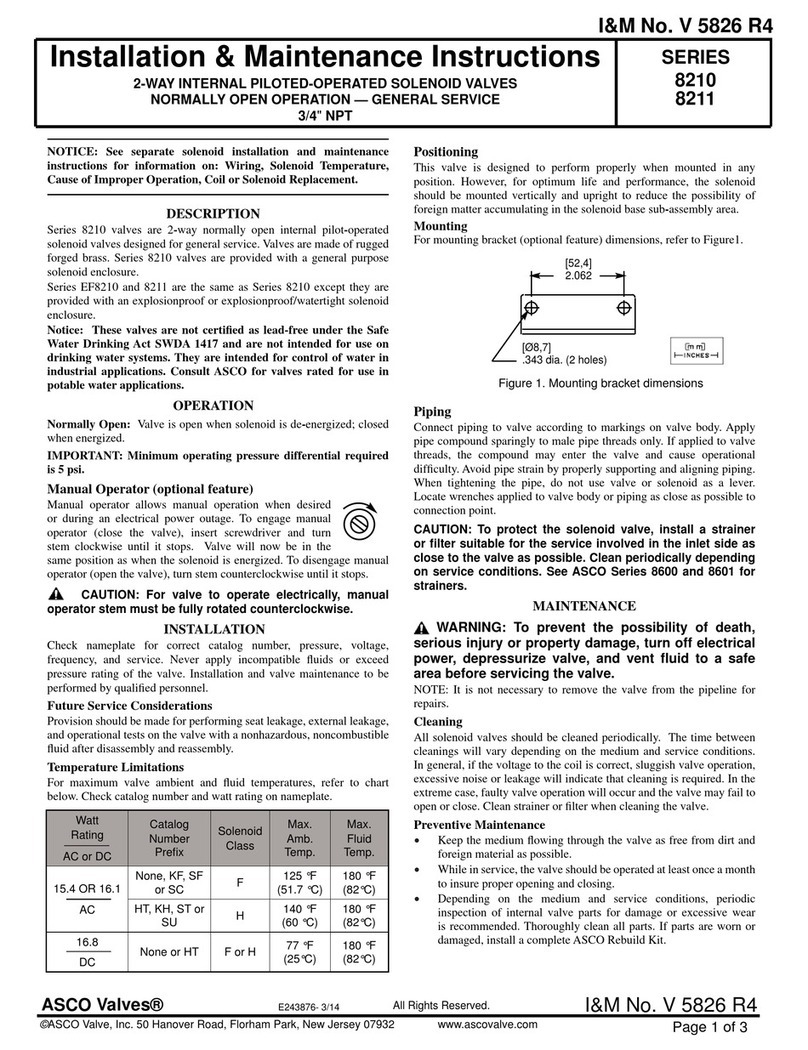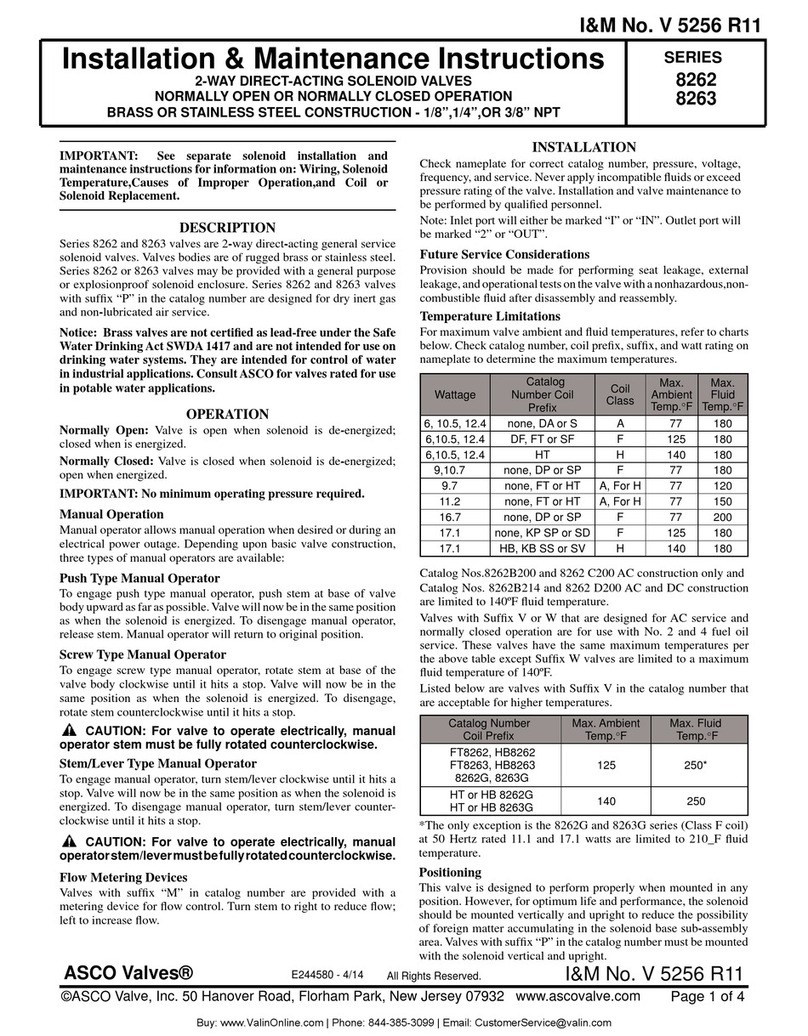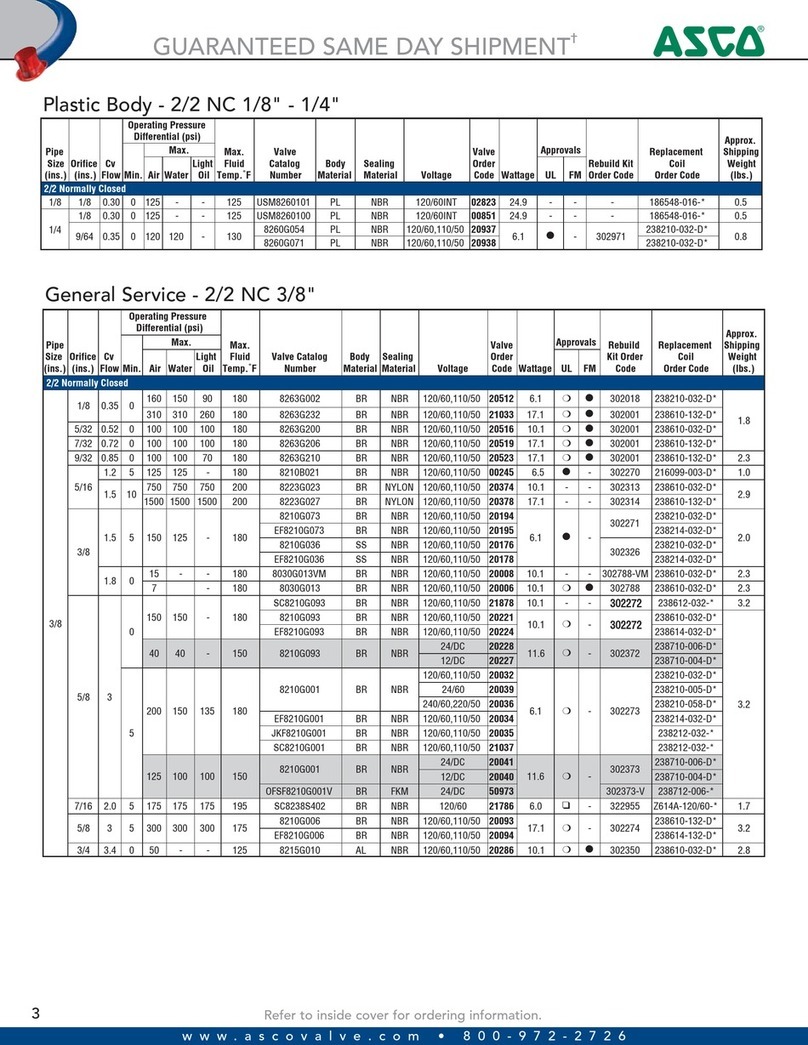
Page 2 of 3 I&M No. V_5590_R5
©ASCO Valve, Inc.50 Hanover Road, Florham Park, New Jersey 07932 www.ascovalve.com
Solenoid Temperature
Standard catalog valves are supplied with coils designed for continuous
duty service. When the solenoid is energized for a long period, the
solenoid enclosure becomes hot and can be touched with the hand only
for an instant. This is a safe operating temperature. Any excessive
heating will be indicated by the smoke and odor of burning coil
insulation.
MAINTENANCE
WARNING: Turn off electrical power supply
and depressurize valve before making repairs. It
is not necessary to remove valve from pipe line
for repairs.
AVERTISSEMENT: Couper l’alimentation
électrique et dépressuriser la vanne avant
d’effectuer des réparations. Il n’est pas
nécessaire de retirer la vanne de la canalisation
pour effectuer des réparations.
Cleaning
Aperiodiccleaningofallsolenoidvalvesisdesirable.Thetimebetween
cleanings will vary, depending on media and service conditions. In
general, if the voltage to the coils is correct, sluggish valve operation,
excessive leakage or noise will indicate that cleaning is required. Be
sure to clean valve strainer or filter when cleaning solenoid valve.
Preventive Maintenance
• Keep the medium flowing through the valve as free from dirt and
foreign material as possible
• While in service, operate valve at least once a month to insure
proper opening and closing.
• Periodic inspection (depending on media and service conditions) of
internal valve parts for damage or excessive wear is recommended.
Thoroughly clean all parts. Replace any parts that are worn or
damaged.
Causes of Improper Operation
• Faulty Control Circuit: Check electrical system by energized
solenoid. A metallic click signifies the solenoid is operating.
Absence of the click indicates loss of power supply. Check for
loose or blown-out fuses, open circuited or grounded coil, broken
lead wires or splice connection.
• Burned-Out Coil: Check for open circuited coil. Replace coil if
necessary.
• Low Voltage: Check voltage across coil leads. Voltage must be at
least 85% of nameplate rating.
• Incorrect Pressure: Check valve pressure. Pressure to valve must be
within range specified on nameplate
• Excessive Leakage: Disassemble valve and clean all parts. Replace
worn or damaged parts with a complete Spare Parts Kit for best
results.
Coil Replacement
Turn off electrical power supply and disconnect coil lead wires.
Proceed in the following manner:
1. Remove retaining cap or clip, nameplate and cover.
CAUTION: When metal retaining clip disengages, it will
spring upward.
ATTENTION: Lorsque le clip de maintien métallique est
dégagé de sa position, il va s’éjecter vers l’extérieur.
2. Slip yoke containing coil, sleeves and insulating washers off the
solenoid base sub-assembly. For D-C Construction, slip spring
washer, coil and insulating washers off solenoid base sub-assembly.
Insulating washers are omitted when a molded coils is used.
3. Reassemble in reverse order of disassembly paying careful attention
to exploded views provided for identification and placement of parts
CAUTION: Solenoid must be fully reassembled as the
housing and internal parts are part of and complete the
magnetic circuit. Place insulating washers at each end of
coil if required.
ATTENTION: La tête magnétique doit être entièrement
remontée car le boîtier et les pièces internes complètent
le circuit magnétique. Si nécessaire placer des rondelles
isolantes à chaque extrémité de la bobine.
Valve Disassembly
1. Depressurize valve and turn off electrical power supply. Proceed in
the following manner:
2. Remove retaining cap or clip and slip entire solenoid enclosure off
the solenoid base sub-assembly.
CAUTION: When metal retaining clip disengages, it will
spring upward.
ATTENTION: Lorsque le clip de maintien métallique est
dégagé de sa position, il va s’éjecter vers l’extérieur.
3. Unscrew solenoid base sub-assembly and remove bonnet gasket,
core assembly and core spring.
4. For A-C Construction without manual operator, remove valve
bonnet screws (4) and remove solenoid base sub-assembly, core
assembly and core spring.
5. Remove diaphragm spring (A-C Construction only), diaphragm
assembly and body gasket.
6. For normal maintenance, it is not necessary to disassemble the
manual operator unless external leakage is evident.To disassemble,
remove stem pin, manual operator stem, stem spring and stem
gasket.
7. All parts are now accessible for cleaning or replacement. Replace
worn or damaged parts with a complete Spare Parts Kit for best
results.
Valve Reassembly
1. Reassemble in reverse order of disassembly paying careful attention
to exploded views provided for identification and placement of
parts.
2. Replace body gasket and diaphragm assembly. Locate bleed hole in
diaphragm assembly approximately 45° from valve outlet.
3. Replace valve bonnet and bonnet screws. Torque bonnet screws (4)
in a crisscross manner to 95 ± 10 inch pounds.
4. For A-C Construction without a manual operator, the diaphragm
spring, core assembly and core spring must be installed prior to
assembly of bonnet as the bonnet is the solenoid base sub-assembly.
Be sure diaphragm spring is installed properly. Large end of spring
to seat on diaphragm assembly. For valve with a manual operator,
the small end of spring seats on diaphragm assembly.
5. Insert core spring into core assembly, core spring and solenoid base
sub-assembly. Torque solenoid base sub-assembly to 175 ± 25 inch
pounds.
6. If removed, replace manual operator stem gasket, stem spring, stem
and stem pin.
7. Replace solenoid enclosure and retaining cap or clip.
8. After maintenance, operate the valve a few times to be sure of
proper opening and closing.
ORDERING INFORMATION FOR
ASCO REBUILD KITS
Spare Parts Kits and Coils are available for ASCO valves. Parts
marked with an asterisk (*) are supplied in Spare Parts Kits. When
Ordering Rebuild Kits forASCO valves, order the Rebuild Kit number
stamped on the valve nameplate. If the number of the kit or the coil
is not visible, order by indicating the number of kits required, and the
Catalog Number and Serial Number of the valve(s) for which they are
intended.

